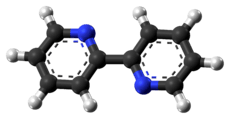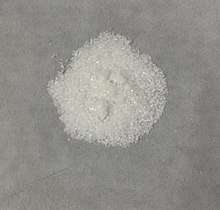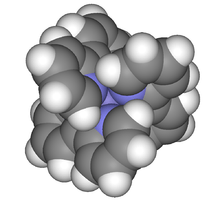2,2′-Bipyridine
2,2′-Bipyridine (bipy or bpy, pronounced /ˈbɪpiː/) is an organic compound with the formula C10H8N2. This colorless solid is an important isomer of the bipyridine family. It is a bidentate chelating ligand, forming complexes with many transition metals. Ruthenium and platinum complexes of bipy exhibit intense luminescence, which may have practical applications.
 | |
 | |
 | |
| Names | |
|---|---|
| Preferred IUPAC name
2,2'-Bipyridine | |
| Other names
Bipyridyl Dipyridyl Bipy Bpy Dipy | |
| Identifiers | |
3D model (JSmol) |
|
| 113089 | |
| ChEBI | |
| ChEMBL | |
| ChemSpider | |
| ECHA InfoCard | 100.006.069 |
| EC Number |
|
| 3720 936807 | |
PubChem CID |
|
| RTECS number |
|
| UNII | |
CompTox Dashboard (EPA) |
|
| |
| |
| Properties | |
| C10H8N2 | |
| Molar mass | 156.188 g·mol−1 |
| Melting point | 70 to 73 °C (158 to 163 °F; 343 to 346 K) |
| Boiling point | 273 °C (523 °F; 546 K) |
| Structure | |
| 0 D | |
| Hazards | |
| Main hazards | toxic |
| GHS pictograms |   |
| GHS Signal word | Danger |
GHS hazard statements |
H301, H302, H311, H312, H319, H412 |
| P264, P270, P273, P280, P301+310, P301+312, P302+352, P305+351+338, P312, P321, P322, P330, P337+313, P361, P363, P405, P501 | |
| Lethal dose or concentration (LD, LC): | |
LD50 (median dose) |
15-78 mg/kg (oral, rat); 20-140 mg/kg (oral, mouse) |
| Related compounds | |
Related compounds |
4,4′-Bipyridine Pyridine Phenanthroline 3-Pyridylnicotinamide Terpyridine Biphenyl |
Except where otherwise noted, data are given for materials in their standard state (at 25 °C [77 °F], 100 kPa). | |
| Infobox references | |
Preparation, structure, and general properties
It is prepared by the dehydrogenation of pyridine using Raney nickel:[1]
- 2C5H5N → (C5H4N)2 + H2
Although uncoordinated bipyridine is often drawn with its nitrogen atoms in cis conformation, the lowest energy conformation both in solid state and in solution is in fact coplanar, with nitrogen atoms in trans position.[2] Protonated bipyridine adopts a cis conformation.[3]
Upon complexation, the related N,N-heterocyclic ligand phenanthroline does not incur an enthalpic and entropic penalty, and thus its complexes tend to be more stable. With respective pKa's of 4.86 and 4.3 for their conjugate acids, phenanthroline and bipy are of comparable basicity.[4]
Reflecting the popularity of this ligand design, many substituted variants of bipy have been described.[5][6]
Coordination chemistry
Illustrative complexes
- Mo(CO)4(bipy), derived from Mo(CO)6.
- RuCl2(bipy)2,[7] a useful precursor to mixed ligand complexes.
- [Ru(bipy)3]Cl2, a well known luminophore.
- [Fe(bipy)3]2+ is used for the colorimetric analysis of iron ions.
Tris-bipy complexes
Bipyridine complexes absorb intensely in the visible part of the spectrum. The electronic transitions are attributed to metal-to-ligand charge transfer (MLCT). In the "tris(bipy) complexes" three bipyridine molecules coordinate to a metal ion, written as [M(bipy)3]n+ (M = metal ion; Cr, Fe, Co, Ru, Rh and so on; bipy = 2,2′-bipyridine). These complexes have six-coordinated, octahedral structures and two enantiomers as follows:

These and other homoleptic tris-2,2′-bipy complexes of many transition metals are electroactive. Often, both the metal centred and ligand centred electrochemical reactions are reversible one-electron reactions that can be observed by cyclic voltammetry. Under strongly reducing conditions, most tris(bipy) complexes can be reduced to neutral derivatives containing bipy− ligands. Examples include M(bipy)3, where M = Al, Cr, Si.
See also
References
- Sasse, W. H. F. (1966). "2,2′-Bipyridine". Organic Syntheses. 46: 5.; Collective Volume, 5, p. 102
- Merritt, L. L.; Schroeder, E. (1956). "The Crystal Structure of 2,2′-Bipyridine". Acta Crystallographica. 9 (10): 801–804. doi:10.1107/S0365110X56002175.
- Göller, A.; Grummt, U.-W. (2000). "Torsional barriers in biphenyl, 2,2′-bipyridine and 2-phenylpyridine". Chemical Physics Letters. 321 (5–6): 399–405. Bibcode:2000CPL...321..399G. doi:10.1016/S0009-2614(00)00352-3.
- J. G. Leipoldt; G. J. Lamprecht; E. C.Steynberg (1991). "Kinetics of the substitution of acetylacetone in acetylactonato-1,5-cyclooctadienerhodium(I) by derivatives of 1,10-phenantrholine and 2,2′-dipyridyl". Journal of Organometallic Chemistry. 402 (2): 259–263. doi:10.1016/0022-328X(91)83069-G.
- Smith, A. P.; Lamba, J. J. S.; Fraser, C. L. (2002). "Efficient Synthesis of Halomethyl-2,2′-Bipyridines: 4,4′-Bis(chloromethyl)-2,2′-Bipyridine". Organic Syntheses. 78: 82.; Collective Volume, 10, p. 107
- Smith, A. P.; Savage, S. A.; Love, J.; Fraser, C. L. (2002). "Synthesis of 4-, 5-, and 6-Methyl-2,2′-Bipyridine by a Negishi Cross-Coupling Strategy". Organic Syntheses. 78: 51.; Collective Volume, 10, p. 517
- Lay, P. A.; Sargeson, A. M.; Taube, H.; Chou, M. H.; Creutz, C. (1986). "Cis-Bis(2,2′-Bipyridine-N,N′) Complexes of Ruthenium(III)/(II) and Osmium(III)/(II)". Inorganic Syntheses. 24: 291–299. doi:10.1002/9780470132555.ch78. ISBN 9780470132555.
